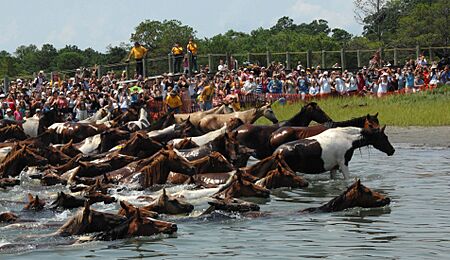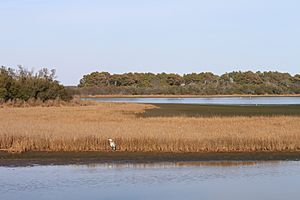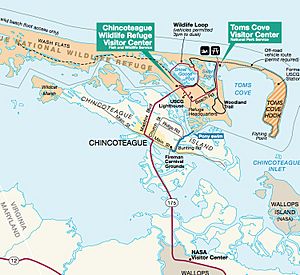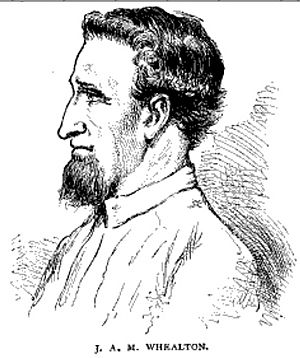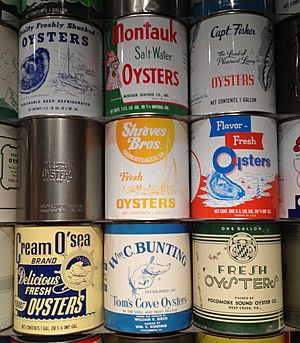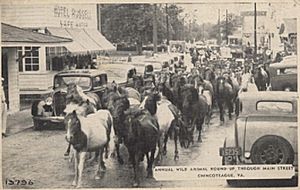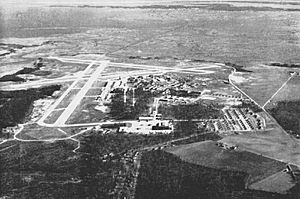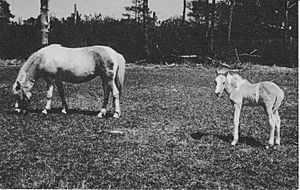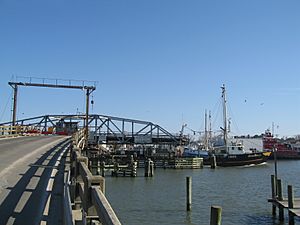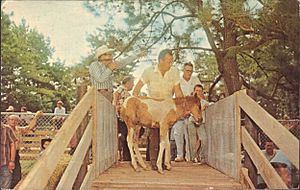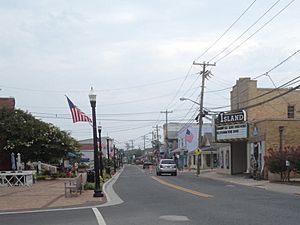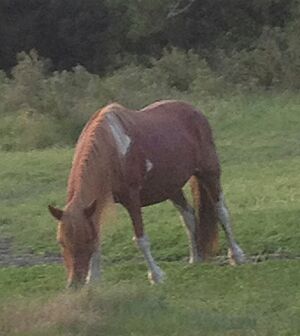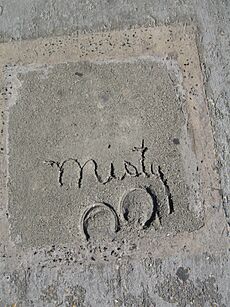History of Chincoteague, Virginia facts for kids
Chincoteague is a famous island on Virginia's Eastern Shore. It has a long and interesting history. Long ago, Native Americans used the island. Later, European settlers arrived. The island is best known for its wild horses, the Chincoteague ponies. These ponies used to roam freely on the island.
Over time, Chincoteague grew from a quiet farming and fishing community. It became a busy place for seafood, especially oysters. The arrival of railroads and roads connected the island to the mainland. This helped it grow even more. Today, Chincoteague is a popular place for tourists. Many people visit to see the beaches and, of course, the famous ponies. The children's book Misty of Chincoteague and the movie Misty made the island and its ponies famous around the world.
Contents
- Chincoteague's Early Days and Native Americans
- European Settlers and the Wild Ponies
- Chincoteague During the American Revolution
- Seafood and Pony Pennings Grow
- Chincoteague During the Civil War
- After the War: Oysters and Visitors
- Becoming a Modern Town (1908–1946)
- Misty of Chincoteague and Island Changes (1946–1962)
- Chincoteague: A Tourist Hotspot (Since 1962)
Chincoteague's Early Days and Native Americans
Chincoteague is both the name of a town and the barrier island where it is located. The island is about 8 miles (13 km) long and 2 miles (3.2 km) wide. It has sandy soil with some loam, which helps pine trees and grass grow. Assateague Island is just north of Chincoteague. It protects Chincoteague from the Atlantic Ocean.
The local Native Americans, called the Chincoteague Indians, did not live on Chincoteague Island itself. They lived on the mainland, where they could hunt and farm. They visited Chincoteague Island to collect shellfish like clams and oysters. Many people say the name Chincoteague means "Beautiful land across the water." However, some historians believe it comes from a Native American word for "large stream" or "inlet."
As more Europeans arrived, the Chincoteague Indians slowly moved north. Many joined other tribes on a reservation in Maryland. Their descendants are now part of the Nanticoke people in Delaware.
European Settlers and the Wild Ponies
Europeans first settled on Chincoteague Island around 1680. The British colonial government had given the land to Daniel Jenifer in 1671. The land was later transferred to Thomas Welburn. To officially own the land, someone had to live there for a year. Welburn had an employee, Robert Scott, live on the island for the required time.
Later, there were legal disagreements about who owned the island. In 1691, a court decided that the island should be divided. It was split between Colonel William Kendall and Major John Robins.
Once the ownership was clear, the island was mostly used for raising livestock. Animals like horses could graze freely without needing fences. This is probably how the Chincoteague ponies came to be. These wild horses became famous. There are legends that the ponies came from a Spanish shipwreck. One such ship did run aground on Assateague Island in 1750.
The first permanent residents were likely George and Hannah Blake in the late 1600s. The island's population slowly grew. By the end of the 1700s, about 200 people lived on Chincoteague and Assateague. Most were farmers or lived on the land without formal ownership.
Chincoteague During the American Revolution
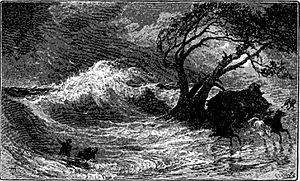
When the Thirteen Colonies decided to break away from British rule in 1776, the people of Chincoteague supported the new nation. The government ordered that livestock be removed from coastal islands to prevent the British from taking them. But the islanders asked to keep their animals. They said they wanted to help "defeat the enemies of American liberty." They even had a group of forty local fighters. So, Chincoteague was allowed to keep its livestock.
Chincoteague's harbor was important during the American Revolutionary War. Ships used it to avoid the British blockade. Smuggled goods were brought ashore and moved to other areas. A fort was built on Wallops Island, near Chincoteague. In 1779, a British ship pretended to be a smuggler. It captured a cargo ship in Chincoteague Bay. Island stories say that four men from Chincoteague fought in the Battle of Yorktown in 1781.
By 1800, the large land areas on Chincoteague Island were being divided into smaller plots. A school was built before 1804, which was unusual for the area. Three families on the island were free African-Americans. One of them, Ocraw Brinney, became a major landowner.
Seafood and Pony Pennings Grow
In the early 1800s, Chincoteague became a big source of seafood. Cities like New York and Philadelphia needed more shellfish. Islanders saw this chance and many stopped farming to harvest seafood. The first post office opened in 1854, and the first doctor arrived four years later. By 1860, there were 150 families on Chincoteague. Many were oystermen. A hotel was also operating in the downtown area.
The first stories about the pony penning come from 1835. At that time, few wild horses were left on Chincoteague Island. Residents would go to Assateague to gather the herds. They would build temporary pens. Selected horses were marked with a brand, and some were sold. People would come from far away to watch these events.
Chincoteague During the Civil War
When the American Civil War began in 1861, Chincoteague faced a tough choice. Virginia wanted to leave the Union. But if Chincoteague did too, they might lose access to their seafood markets in the North. The islanders voted overwhelmingly to stay with the Union. This was different from most of Virginia.
Even before the vote, trade between the North and Virginia was stopped. John A.M. Whealton, a merchant and strong Union supporter, went to Philadelphia. He got permission for the islanders to continue trading. In September 1861, a Union ship, the USS Louisiana, arrived. It was there to stop smugglers. The islanders welcomed the ship and promised their loyalty to the Union. They were allowed to keep trading.
The war did not greatly affect Chincoteague after this. Union soldiers were stationed on the island for about four months in 1863 and 1864. They guarded against any attacks.
After the War: Oysters and Visitors
After the Civil War (1865–1908), Chincoteague became very successful because of the oyster trade. Many oystermen moved to the island. Chincoteague oysters, especially from Tom's Cove, became famous across the country for their taste. They were sold as "Chincoteague salt oysters."
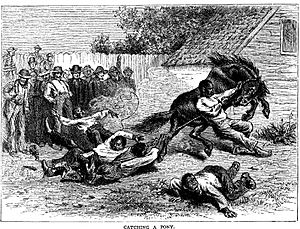
In 1876, art student Howard Pyle visited Chincoteague. He wrote about his experiences in Scribner's Magazine. He also drew pictures of the pony penning. Pyle described Chincoteague as "an enchanted island, cut loose from modern progress." His article helped make the island and its pony penning even more popular.
Chincoteague's isolation began to end in 1876. A railroad reached Franklin City, just 5 miles (8 km) from the island. A steamboat then connected Franklin City to Chincoteague. This made it easier to send oysters to market. It also brought early tourists who wanted to escape the city heat.
The island continued to grow. Commercial buildings appeared along Main Street. By 1900, gas lights arrived. The first telephone exchange opened in 1902. The roads were made of dirt and covered with seashells.
Becoming a Modern Town (1908–1946)
In the early 1900s, Chincoteague was a mix of old and new. Residents wanted the island to become an official town. This would allow them to make local rules, like keeping livestock off the streets. In 1908, part of the island became the Town of Chincoteague. A. Frank Matthews became the first mayor.
By 1910, the island had a population of 3,295 people. Most lived in houses facing the water. Most working islanders were involved in the seafood trade. Water came from shallow wells, which were often close to outdoor toilets. This led to health concerns. In 1916, the Public Health Service stepped in. They asked the town to improve sanitation.
The pony penning on Assateague Island stopped after 1920. The largest landowner would not allow access. Starting in 1923, the Assateague ponies were brought to Chincoteague for a combined penning. Most of Assateague Island was sold to the federal government in 1943.
In 1919, a plan began to build a causeway from the mainland to the island. This road would have tolls. A major fire destroyed much of downtown Chincoteague in February 1920. The fire was fought by the Coast Guard. The causeway finally opened on November 15, 1922. It was a big success, bringing over a hundred vehicles a day. Water from mainland wells was piped along the causeway, giving the town running water.
Another big fire in February 1924 led to the creation of the Chincoteague Volunteer Fire Company in June 1925. To raise money, the fire company took over the 1925 pony penning. They sold some horses. Fifteen thousand people came to the event. The money helped them buy a fire truck. That year, the pony swim was started. The ponies swam across the narrow channel between the two islands. This made the event even more popular. The carnival, pony swim, and auction have happened every year since, except during wars and pandemics.
By 1930, the causeway became toll-free. Poultry farming became popular on the island in the 1930s. By the 1950s, it produced over a million birds a year. Many watermen also turned to fishing, clamming, and crabbing. Locals carved duck decoys for hunting. These are now popular souvenirs.
In 1941, the United States entered World War II. The Navy built the Chincoteague Naval Auxiliary Air Station in 1943. Future president George Herbert Walker Bush trained there as a pilot. The war ended in 1945. Celebrations were held, and the annual July events, including the pony swim, returned.
Misty of Chincoteague and Island Changes (1946–1962)
In 1946, children's author Marguerite Henry visited Chincoteague. She wanted to write about the wild horses and the pony penning. She met island horse breeder Clarence Beebe and his grandchildren, Maureen and Paul. Henry saw a young filly named Misty at the Beebe Ranch. She loved Misty and bought her, promising to include the Beebes in her book.
In 1947, Henry's book Misty of Chincoteague was published. It was about the Beebe children wanting their own pony, Misty. The book became a huge success. It was even named a Newbery Honor Book. After the book came out, many articles about Chincoteague appeared in national magazines.
The movie Misty began filming in 1960. Most of it was shot locally. The movie premiered in Hollywood and at the Roxy Theatre in Chincoteague at the same time. The real Misty even placed her hoof in wet cement outside the Roxy.
Even with the new fame, many young people left Chincoteague after World War II. There was no beach on Chincoteague itself. So, people wanted a bridge to Assateague Island, which has an Atlantic beach. This bridge finally opened in September 1962. It connected Chincoteague to Assateague.
The town stayed busy and successful. In the early 1950s, Chincoteague won awards for being one of the cleanest communities in America. When oyster diseases hurt the oyster industry in the 1950s, clams became the main industry. The Burton Clamming Company was said to be the largest in the world.
The Ash Wednesday Storm in March 1962 caused a delay in the Assateague bridge. The storm flooded almost all buildings on Chincoteague. It destroyed the poultry industry, killing many birds. About one hundred ponies also died. Misty, who was pregnant, was moved to the Beebes' kitchen for safety. After the storm, she gave birth to a filly named Stormy. The storm brought national attention to Chincoteague. Many people helped with the recovery efforts.
Chincoteague: A Tourist Hotspot (Since 1962)
Before the 1950s, most tourists came to Chincoteague for fishing or hunting. But the fame from Misty and easy access to Assateague's beaches brought many new visitors. These tourists were more interested in taking pictures of wildlife than hunting. As the seafood industry declined, Chincoteague's economy slowly changed. It became focused on tourism.
Many souvenir shops and tourist businesses were built along Maddox Boulevard after 1962. At first, motels were converted buildings. But by the late 1960s, new motels with swimming pools were built. Even after Misty died in 1972 at age 26, the island remained popular. By the 1990s, tourism was the island's main business. Big hotel chains like Hampton Inn also arrived.
Changes came to Chincoteague, including the sale of the Beebe Ranch in 1989. Islanders had different opinions about new developments, like a McDonald's near the bridge. Many modest homes were joined by townhouses and condos. With higher real estate prices, some islanders sold their land and moved to the mainland. The seafood industry became less important. Most oyster-shucking houses closed in the 1980s and 1990s.
In 1989, the town expanded to include all of Chincoteague Island. The bridge between Chincoteague and Assateague was rebuilt into a four-lane structure in 2010. This was to handle the millions of visitors each year. The causeway from the mainland was also changed. It now ends north of downtown, at the intersection of Main Street and Maddox Boulevard. From there, visitors can go to downtown or to the tourist shops and the bridge to Assateague.
The tourist shops on Maddox Boulevard sell souvenirs, local art, beach supplies, and pony-themed items. In 2009, the average foal at the pony auction sold for $1,344. Between 60 and 80 ponies are sold each year. The auction helps keep the pony herd at a healthy size of about 150. In 2020 and 2021, the pony swim and related events were canceled due to the COVID-19 pandemic.
James Tigner Jr. wrote in his 2008 book about Chincoteague Island:
In the book and in real life, the story of Misty is really of those who loved her unconditionally. For that reason Misty today is a symbol for all that is wonderful and beautiful... From my visits I know that much of the good that Misty represents can still be found on her little island of Chincoteague.


